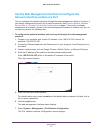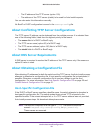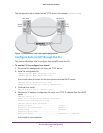
Use the Auto Install Configuration
19
M6100 Series Switches
Auto Install Configuration Concepts
The downloaded configuration file is not distributed across the chassis. When an
administrator saves configuration, the configuration file is distributed to all blades.
The Auto Install process requires you to enable DHCP. The downloaded configuration file is
not automatically saved to the startup-config file. An administrator must explicitly issue
a save request to save the configuration. The Auto Install process depends on the
configuration of other devices in the network, including a DHCP or BootP server, a TFTP
server and, if necessary, a DNS server.
Auto Install occurs in three phases:
1. Configuration or assignment of an IP address to the switch
2. Assignment of a TFTP server
3. Downloading a configuration file for the switch from the TFTP server
Switch IP Address Assignment Concepts
If BootP or DHCP is enabled on the switch and an IP address is not yet assigned, the switch
requests an IP address assignment. The IP address assignment through BootP or DHCP
normally functions with the Auto Install feature. That is, the following information that is
returned from the server is recognized:
• The IP address (yiaddr) and subnet mask (option 1) to be assigned to the switch.
• The IP address of a default gateway (option 3), if needed for IP address communication.
Some network configurations require the specification of a default gateway through which
some IP address communication can occur. Option 3 of a BootP or DHCP response
specifies the default gateway
.
After an IP address is assigned to the switch, if a host name is not already assigned, then
Auto Install issues a DNS request for the corresponding host name. This host name is also
displayed as the CLI prompt the same as if the
hostname command was used.
TFTP IP Address and Configuration File Name Concepts
A BootP or DHCP server might return the following TFTP configuration file and IP address
information:
• The name of the configuration file (bootfile or option 67) to be downloaded from the TFTP
server.
• The identification of the TFTP server from which to obtain the bootfile. See the following
fields:
- The host name of the TFTP server (option 66 or sname). Either the
TFTP address or
name is specified, not both, in most network configurations. If a TFTP host name is
given, a DNS server is required to translate the name to an IP address.


















